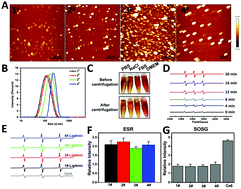Light-assisted gadofullerene nanoparticles disrupt tumor vasculatures for potent melanoma treatment†
Abstract
The traditional photodynamic therapy (PDT) using a photosensitizer and oxygen under light generates reactive oxygen species (ROS) to kill tumor cells. However, its treatment efficiency is limited by insufficient oxygen in tumor cells. Herein, β-alanine modified gadofullerene nanoparticles (GFNPs) were explored to disrupt tumor vasculatures assisted by light for potent melanoma treatment. As tumor vasculatures are oxygen-rich, the yields of photo-induced singlet oxygen (1O2) by GFNPs are not subjected to the hypoxemia of tumor tissues. Different from the small molecule photosensitizer Chlorin e6 (Ce6), GFNPs realize high-efficiency tumor vascular disruption under light observed by using the mice tumor vascular dorsal skin fold chamber (DSFC) model. The tumor vascular disruption efficiency of GFNPs is size-dependent, and the smallest one (hydration diameter of ca. 126 nm) is more efficient. Mechanistically, the high yields of photo-induced 1O2 by GFNPs can lead to the destruction of the tumor vascular endothelial adherent junction protein–VE cadherin and the decrease of tumor vascular endothelial cells-CD31 proteins, inducing rapid tumor necrosis. In conclusion, our work provides an insight into the design of well-sized nanoparticles to powerfully treat melanoma assisted by light, as well as greatly extending the applications of PDT for robust tumor therapy.



 Please wait while we load your content...
Please wait while we load your content...